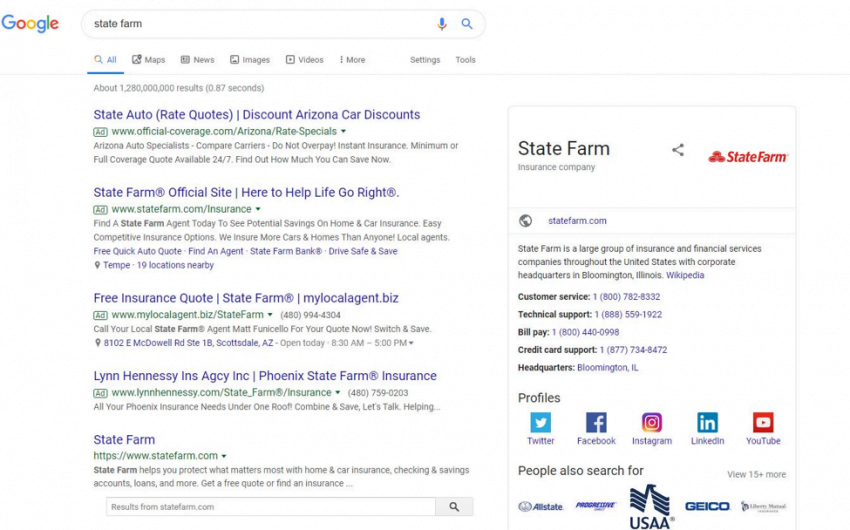With paid search features, tactics, and physical layouts changing so often, it’s important to stay competitive to come out on top against your competitors. In this article, we discuss some of the best ways for you to stay competitive in paid search, even while it changes so frequently.
Branding
If you are in a competitive industry, which if you’re reading this, we can assume you are, you want to be sure you know your brand and know it well. Too often, companies run paid search campaigns that are misaligned to their brand, presenting a different image of themselves in ad copy than what they truly are. To avoid this, be sure your brand is conveyed the same way across your ad copy, landing page(s), and website.
In addition to keeping your brand aligned, try running a brand campaign to bid on your own keywords. If you’re one of the top companies within your industry and your competitors know that, and are running paid search campaigns, chances are good that they may bid on your brand terms to try and get your customers to come to them. To help combat this, bid on your own brand terms so you outrank the competition and your customers see your ads. While there is cost associated with bidding on your own terms, since they are your brand terms you will most likely have a higher quality score and your CPCs (cost-per-click) on these will be cheaper than your overall terms.
Competitive Research and Conquesting
Learning who your competitors are and what they are offering to customers is another great way for you to stay competitive in paid search. While it’s a good idea to do competitive research when you’re first starting a campaign, it’s good to do it every couple of weeks or months as competitors come and go and may change their strategies along the way.
A few starting points for your research are looking at competitor websites, paying attention to how they are talking to their customers both through ads and their website, and taking note of what offers they have. If you’re already running paid search campaigns, utilizing Google tools and metrics can help give a glimpse of how your competitors are showing with your campaigns. Using Auction Insights within Google Ads allows you to see how often your competitors are showing ads when you are, and how competitive or aggressive they might be in their strategy. You can dive even further by looking at your impression share metrics by time of day, day of week, and even device type to see when the competition is really pushing things or when they may be pulling back.
Just as competitors may be bidding on your branded terms, you may want to look at bidding on their terms as well. While this doesn’t mean you need to be hyper aggressive in your bidding on these terms or be malicious about it, it could be worth catching the attention of customers who know your competitors and haven’t yet committed to a service provider or retailer.
Here is an example of a competitor conquesting the brand name of another company and having their ad rank higher than that company.

Switch Up your Strategies: Test, Optimize, and Repeat
Switching up your paid search strategies is another way to stay in front of your competitors. If you let your campaigns sit in the same place strategically for too long without making big chances, you can start to fall behind your competitors who are out there making strategic changes. This doesn’t necessarily mean you should change everything you’ve been doing, but maybe look at testing out new strategies for your campaigns.
A couple different strategies for you to test out are dayparting, device bidding, audience layering and bidding, and even different search engines. If it’s been a while since any new strategies have been implemented on your campaigns, you should have enough data collected to decide where your next strategic move could be. You may see within your data that certain days of the week are better performing than others, so testing out a strategy to improve the other days of the week could be good for your campaigns. Again, these don’t have to be massive changes, but it is worth testing it out.
Continually testing and optimizing within your campaigns is going to be one of the best ways for you to remain competitive and keep that competitive edge going. Whether you’re testing a new bidding rule, a specific piece of ad copy, or a callout on a landing page, you want to be sure you are always running some type of test and collecting data. Like mentioned earlier, don’t let your campaigns just sit without any changes. The mindset of “set it and forget it” will cause more harm than good, and eventually will put you behind your competition.
If you’re not sure where to start on optimizing your campaigns, check out our Favorite Paid Search Optimization list.
Take Advantage of the Latest and Greatest
With digital advertising changing so rapidly, it’s important to stay aware of and implement the latest and greatest features Google and Bing have to offer for paid search. Occasionally, Google will release a beta to a new product or feature for paid search and will allow advertisers to be a part of the test group for that beta. If you’re able to get access to a new beta from Google, this is good opportunity for you to test out new features right away and learn them before your competitors start using them. By the time the beta gets rolled out to everyone, you’ll already be a pro at it and a step ahead of your competitors.
Align Your Paid Search with SEO
Paid Search and Search Engine Optimization can go hand-in-hand with one another, and it’s important that you consider starting or revamping an SEO strategy for your business to improve and increase your presence on the search engines. To learn more on how paid search and SEO work together, check out our article here.
Conclusion
Keeping up with a changing paid search environment while also trying to stay competitive in your strategies can take a lot of time and effort, but as your campaigns become more and more efficient and effective, it’ll all be worth it.
